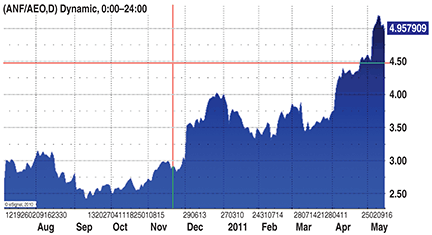Q&A
Since You Asked

Confused about some aspect of trading? Professional trader Don Bright of Bright Trading (www.stocktrading.com), an equity trading corporation, answers a few of your questions. To submit a question, post it on the Stocks & Commodities website Message-Boards. Answers will be posted there, and selected questions will appear in future issues of S&C.
REVERSING THE NEGATIVE EFFECTS
Mr. Bright, thanks for your column, I read it every month, it really helps. A while back I read about how some of your traders have taken advantage of what seemed to be a negative situation. High-frequency and subpenny trades take place with more frequency these days, and I think you said something about how to reverse the negative effects. Could you possibly go into that again, please? —coyotejk
Sure, let’s start with a quick review of what we’re addressing. Automated computer programs can and do send in high-frequency trading orders in subpenny increments. The guise is that they may offer some price improvement to the other side of the order. Much has been analyzed about the pros and cons of this type of trading. I suggest you check out www.defendtrading.com for background and continuing information about these very important aspects to trading these days.
For example, let’s assume you purchased 500 shares of Xyz at 20.12 and decided to offer the stock back at 20.45. You see the current displayed bid and offer as 20.44 bid, and your offer at 20.45. Great, right? Well, now you see multiple trades go by at what appears to be 20.44, but the bid remains. A bit disconcerting. Upon further review, you see that these trades are actually going by at 20.447, or 20.449. These subpenny trades are going up in front of your offer, even though you are the best “displayed” offer for the world to see.
At first glance, it may look as though the benefit of a fraction of a cent is going to the buyer, who was trying to pay 20.45. This can be a point of discussion, but since you are the trader who is displaying the best offer and taking the risk, many others contend you are being taken advantage of. Those computerized trades are basically leaning on your offer with a risk of only a fraction of a cent, while your risk is always the bid/ask spread of a penny or more.
Automated computer programs can send in high-frequency trading orders in subpenny increments.I won’t go into the dynamics or politics, but I will answer your question. Our traders set their time & sales blotter (ticker) for a full four-decimal places. This serves a couple of purposes, primarily to see if the stock you are actively trading is being subjected to these Hft subpenny trades (most major issues are). Now you can see both how many shares and how often these trades are taking place. You should also see where they are being made (which electronic communications network or exchange). You cannot enter subpennies, at least not yet, but you can see if your offer is being leaned on. You have a choice to retract your order and simply hit the current bid, use a market order (not generally a wise alternative), or simply back away for the time being.
Another benefit my traders are seeing is these trades seem to work like the old-fashioned tape-reading, wherein you can see how many shares are working on the higher end of the pricing, when and at what price levels your stock is being hit by the Street, and so on. This can show strength or weakness, and will be more and more obvious as you watch this action.
I hope this helps.
DOLLAR VALUATION
I have a question regarding the valuation of the dollar. Do your traders study and watch such things as the relationship of the US dollar to other currencies? Is this important in trading equities? — erichod
Good question. As most traders know, there is an inverse relationship between the value of the US dollar and overall market pricing. The basic thought is that the company is worth the same; it just takes more dollars to buy it based on when the value of the Usd goes down. Traders need to check their stocks to see if they are not keeping up with the overall market but seem to be maintaining similar earnings. If all else seems good, then you should check domestic vs. international sales and other currency-related factors.
But it’s more than that. I checked with my expert, Rob Friesen, president of our PairCo wing (www.pairtrader.com). He says Aeo (American Eagle Outfitters) and Anf (Abercrombie and Fitch) are good examples. Anf had a 61% net increase in international sales in the fourth quarter reported February 2011. The attached ratio chart will show you what I mean (Figure 1).

Figure 1: ANF vs AEO Daily Ratio Chart